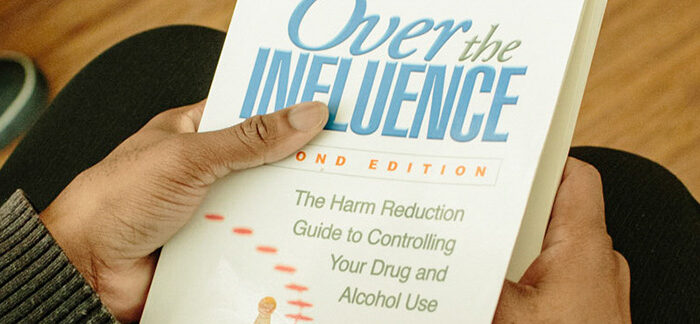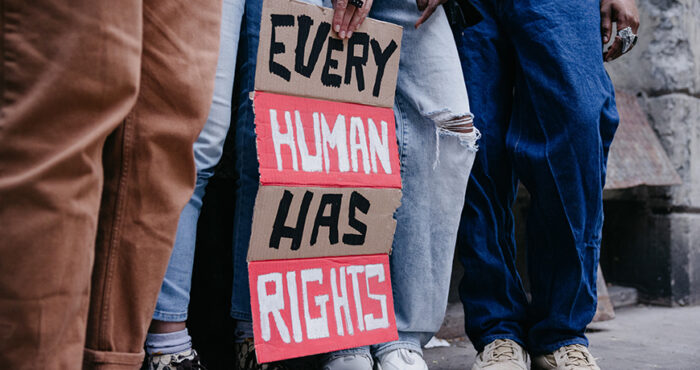Harm reduction wisdom

I do weekly foot outreach in the Tenderloin providing safer use supplies to San Franciscans experiencing houselessness in addition to anyone who asks for something.
There was once when a government employee in a position of power yelled at me from the other end of the block, “YOU’RE KILLING THOSE PEOPLE WITH THAT FOIL!” I was alarmed to be spoken to this way for supporting my community. Didn’t he know we’re funded by the Department of Health? I thought. If he has such an issue, why doesn’t he take it up with them instead of yelling at me, a wage-worker?
Another time, a community member stopped dead in his tracks when he spotted me with the wagon and said, quite sarcastic and sneeringly, “Thank you. Thank you so much for KILLING OUR COMMUNITY and keeping people addicted to drugs!” I always found it strange that people reacted with such vitriol when I, myself, was someone in recovery. I have an informed viewpoint, after all.
Harm reduction has saved my life. Transformed my life. Fill in the blank with a positive verb and chances are that harm reduction done it.
I struggle a bit with this topic because harm reduction is so many things that it’s actually difficult to put it on paper. People tend to think it’s just clean needles, or Narcan (the name brand for Naloxone, the drug used to reverse opioid overdoses), or simply doing less of a thing. It is some of those, sure, but “harm reduction” is really just a term that refers to a wide variety of practices and treatment modalities (which encompass and include the most widely-known form of recovery, full abstinence from all drugs and alcohol).
I should also point out that the following description will not fully encompass every potential aspect or type of harm reduction, but I’ll discuss some of the central tenets of harm reduction that I, personally, have experienced.
We’ll start with some descriptions of harm reduction from folks currently practicing various methods of harm reduction.
“Harm reduction means a much deeper, inclusive sense/ approach to self-care, which paves the way to holistic solutions for wellness and recovery in general.”
“For me, harm reduction is a conscious effort in taking better care of myself. This includes decision-making, setting flexible goals and adjusting to life’s problems. I also, through engaging in harm reduction recovery programs have changed my thinking about many values ingrained in me from my upbringing. Finally, HR brings boundaries around the media and man-made propaganda.”
“Harm reduction is empowering people to find, and sometimes create, the recovery pathway that works best for them. In short, harm reduction is an act of love.”
One way to draw some clear delineations is to discuss what harm reduction is not.
Harm reduction is not enabling. There’s a good book that touches upon this called Over the Influence. In a chapter titled, “Letter to Family and Friends,” the authors discuss what it really means to “enable” someone’s addictive behaviors, and conclude that the only way you can really enable anyone’s drug use is by actually supplying them with drugs and/or alcohol (which I consider more or less indistinguishable from “drugs”).
Of course, we can enable safer drug use by guiding in the direction of clean needles, making sure we have our own pipes, etc. One thing the authors discussed that radically transformed, frankly, my entire worldview, is “both/and”; we can both continue to love someone and decide we need to live separately from them.
We can both tell someone we can no longer hear about their chaotic use because it’s difficult for us emotionally and encourage them to seek professional or community support. We can both tell someone they need to move out of our apartment or house and set this boundary in a compassionate way (perhaps it looks like giving two months notice, perhaps it looks like spot-covering their security deposit at their next place if they can’t afford that at the moment, perhaps it means–for parents, for instance–subsidizing their new apartment cost for a finite time period because we don’t want our child to end up evicted and on the streets, etc. This can look very different depending on our situations and context).
No one said harm reduction is easy. No one said it’s easy to love someone. Love is hard. Love is work. Love is commitment. Love is messy. Love can exist in the greys and blues, the hues of a spectrum based on feeling, lessons, and intuition.
Harm reduction is not necessarily abstinence-oriented.
Most people think of harm reduction simply as a stepping stone to full abstinence. Sure, this is the case for some people, but not for all. Some people have no desire to stop using their substance of choice, and that’s okay, because it’s their choice. We have to respect people’s autonomy to make their own decisions.
Harm reduction is not necessarily a “fixed” or “one-time” decision.
People tend to think of harm reduction like full abstinence, as if it’s a decision you make a single time that should be unchanging for the remainder of one’s life (and if it’s not, and you decide to change things, you have somehow “failed”). This is just silly, when you think about it. What other decision do you make right now that you are expected to maintain for the rest of your entire life? Harm reduction is a method of self-exploration, a tool to better get to know ourselves, and to create a recovery pathway that makes sense for us at the present moment. It’s a progressive practice.
I want to give an example that may make this make a little more sense. I have a good friend who endured a significant trauma recently. They had been abstaining from drinking alcohol, their drug of choice, for months. But after their trauma, they decided that the relief the alcohol would temporarily bring them, when they couldn’t bear the pain any longer, was worth any risk related to their drinking. Their alternative, at that point, they said, was suicide.
The alcohol, in a controlled dose, provided them a dose of euphoria that relieved some of the dark thoughts they were having. (It is worth noting that the key phrase in that sentence is “controlled dose”. Please also note: this is what this individual found worked best for them at the time. They may find, after a few weeks, that the cost may begin to outweigh the benefits. Should that arise, we can reassess).
This all would of course lead us to say that harm reduction is:
- “both/and”
- Love
- Abstinence (a simpler way of stating this would be that “abstinence is a form of harm reduction”)
Most people think abstinence and traditional twelve-step Alcoholics Anonymous-esque programs are actually in contradiction with harm reduction. I would argue this is simply not the case. Full abstinence from drugs is, for some, a highly effective form of harm reduction. Does it reduce the harm caused by chaotic drug use and substance use disorder? Yes, I’d reckon it does. It can be reasoned, then, that abstinence is one highly popularized form of harm reduction. I think of “sober” like Kleenex. Everyone calls tissues Kleenex because it’s the most well-known brand. Abstinence and sobriety are the Kleenex of harm reduction. But there are other brands of tissues, and some of them work just as well or better for different people!
I can also tell you what some of the more technical aspects of harm reduction are. They are as follows:
Medication-Assisted Treatment
Some people take a prescription medication, such as methadone and suboxone, to treat opioid dependence. There are also treatments like Naltrexone that can be used to curb alcohol cravings.
Targeted abstinence
It’s as it sounds: targeted abstinence means that you’re honing in your abstinence onto one substance, or specific substances. For instance, a person might choose to be fully abstinent from alcohol and stimulants while still using cannabis and psychedelic mushrooms. Or they may choose to only stop using opioids while using dissociatives regularly.
Substance use management
Again, as it sounds: we’re managing our substance use! This may look very different for different people and different substances. Perhaps one person chooses to only drink on weekends, while one person chooses to smoke weed every other day rather than every day. One person may say, “You know what, I’d like to start injecting with only unused needles so I don’t get hepatitis C again”, while another person may say, “I’d like to stop injecting and only do lines.” It really does look different for every person based on their individual needs and goals.
And then, I think it’s worth discussing the big four: drug, set, setting, and dosage.
Drug: What drug or combination of drugs are we doing?
I remember when I first went to rehab and they said to me, “A drug is a drug is a drug.”
Hold up, I thought. Huh? What they meant, of course, was that it doesn’t matter what substance we put into our bodies, we are still looking to alter our consciousness and “escape” (in their eyes), so there really is no notable difference between any psychoactive substance we use.
What does your gut tell you about that? Perhaps it says something different from mine, but my initial reaction was, That is the biggest bunch of horse shit I have ever heard. But everyone around me bought it! Or at least they pretended to—or perhaps it really was applicable to them. However, I couldn’t believe that someone was really trying to tell me my relationship to, say, alcohol, was the exact same as my relationship to cocaine.
Of course, there is something to be said for people being in denial, but the truth is that even if my relationship to alcohol was destructive and my relationship to cocaine was destructive, they may not have been destructive in the exact same way and to the same extent. To pretend they are is disingenuous, and also dangerously ignores important differences that may be key to managing the use of both substances.
In my time in recovery, I’ve met people who struggled with a wide variety of substances (and acts), from sugar to porn to alcohol to meth to opiates to cannabis to DMT to heroin to fentanyl to sex to overeating to gambling to pills–you name it, it probably exists. So to tell someone who has no issue whatsoever with, say, psychedelic mushrooms that this is the exact same thing as their issue with pills is just flat out incorrect.
Of course, there is room for exploration and discussion around the genetic components of addiction, and also the general idea of having developed such an addictive behavior that we have virtually decimated our ability to utilize our executive functioning/decision-making/impulse control. That would be disingenuous of me to not include that in this conversation. But again, notice what I’m saying: There is room for exploration and discussion. Harm reduction is not “one-size-fits-all”.
The other thing about this kind of all-or-nothing thinking is that it doesn’t allow people with, say, problematic use to explore their struggle before it becomes a full-fledged somatic dependence. If we say to people flat out, “You are either a drug addict or you’re not, you’re either addicted or you’re not”, this really does a disservice to people the world over.
A very simple comparison I could give would be that we don’t tell someone struggling with food addiction or compulsive eating that “Food is food is food.” We recognize, instinctually, that all foods are different, and not just that, but our relationships to all foods are different. We all know, beyond a shadow of a doubt, that it would be downright silly to tell someone the broccoli they’re overeating is no different from the 4 bags of potato chips they also ate. These are different food items with completely different nutrient profiles. Now, that is not to say that overeating broccoli is not problematic because overeating, of course, may come from some kind of compulsion rather than actual hunger. I just want to make the point that it’s essential to tease out the objective truths from stigma around substance use.
Set: The “set” refers to the people with whom we are using.
Me using alcohol with my best friend may be a very different experience than me using alcohol with my ex. A person using poppers by themselves may have a totally different experience than a person using poppers to have sex in a bathhouse versus using poppers to enhance their experience at a club. A more clear-cut example of this would be using with people we know versus people we’ve just met. We may discover, after using, that the person or people we’re with are not who we thought they are, or perhaps that the drugs changed their behaviors.
For instance, I have used with people I thought were decent people, and then suddenly they were extremely angry, even menacing, accusing me of stealing from them even though I had stolen nothing. The flip side is that a substance may bring out a part of us we are unaware of, whether it be depression, anxiety, paranoia, or even a psychotic break. It’s important we take into account who we let into our sphere when we’re in a place of vulnerability.
Setting: It’s very different using at home than out at a bar!
It’s very different drinking alcohol at a music festival than alone in our rooms. It can be very different using somewhere substances are decriminalized or legalized versus somewhere they are illegal. This literal geographical context is essential to making or breaking our experience.
Dosage: How much are we using?
I remember in college there was a party and we all decided to pregame with 5 shots. We took these in quick succession and then headed out to the party. Needless to say, I don’t remember much of the night. Dosage is so important when it comes to creating the experience we want. Example questions I ask myself: How much am I using? How much am I using compared to last time? Is this product or batch stronger than the last time? Dosage is so important when it comes to creating the experience we want.
For me, at the end of the day, harm reduction is an end to suffering—or, at least, a commitment to decreasing it. We’ve established what some of harm reduction is, some of what it’s not, and we’ve also broken down various modalities and methods of harm reduction, and beyond that, the analysis of our relationship with our chosen substance(s). Harm reduction is a lot of things, certainly, but I think to me most of all, harm reduction is possibility.









